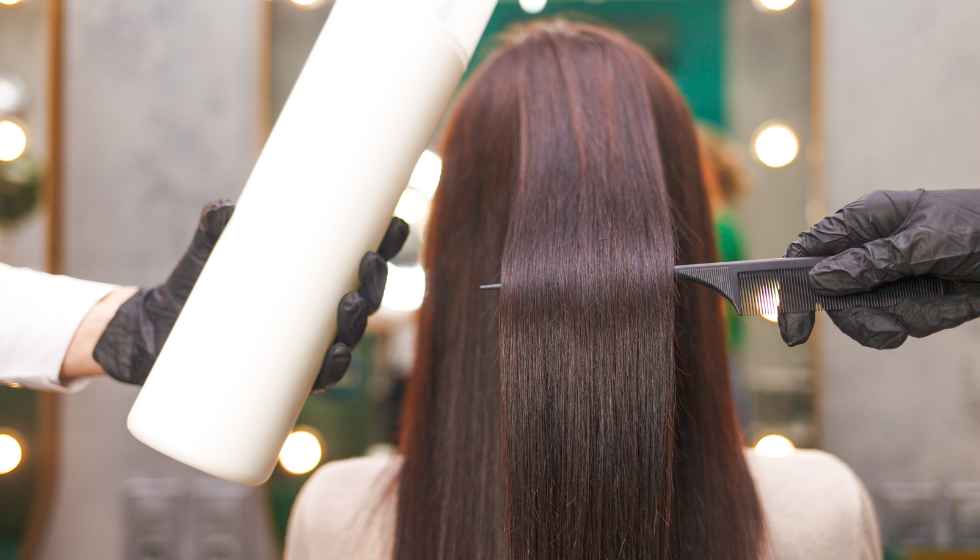Girls with straight hair often dream of curls and those with curly hair dream of straightening them. Let’s figure out with the help of experts how nanoplastics can help with this.
Pros, cons, composition for nanoplasty and hair care features after the procedure.
What is hair nanoplasty
Hair nanoplasty is a professional care procedure for filling hair with organic acids. This is an alternative to keratin straightening but with a more natural composition. The main task of nanoplasty is to smooth out the strands, make them shiny, and remove frizz. As a result, the hair acquires a mirror shine, is easier to comb and does not require styling with a hot iron.
Initially, the procedure appeared in Brazil, and in the early 2010s, it came to Russia. Today, this is one of the safest ways to straighten your hair for a long time and saturate it with useful microelements and vitamins.
Cost of the procedure
On average, one nanoplasty procedure will cost 3–8 thousand rubles. Depending on the salon’s pricing policy and the experience of the specialist. The exact cost is discussed at a preliminary consultation with the master, who will assess the condition and thickness of the hair.
Hair Nanoplasty or Botox
Botox is aimed at moisturizing, restoring and nourishing hair. The main difference between Botox and nanoplasty is that it does not have a straightening effect, although the strands can be smoothed by filling the hair cuticle. Nanoplasty is used mainly for straightening but also helps improve hair condition.
Hair nanoplasty or keratin straightening
Keratin straightening is used to smooth out curls, as well as nanoplasty. However, paying attention to the composition is essential: formaldehyde or its derivatives are used in the keratin procedure, and nanoplastics are a more natural option. Keratin straightening products have a specific smell; sometimes, they can cause allergic reactions. Nanoplasty is hypoallergenic.
Pros and cons of hair nanoplasty
Among the apparent advantages of nanoplastics are the following:
- The safety of the composition in comparison with many analogs;
- No burning sensation or unpleasant odor during heat treatment;
- Complex effect: The hair is not only smoothed but also saturated with vitamins they begin to look dense and healthy;
- Minimal risk of adverse reactions – allergies or dandruff – including because the composition does not come into contact with the scalp;
- Long-lasting effect, effortless styling and care – up to six months after the procedure.
Nanoplasty also has its disadvantages, so before undergoing it, you should consult with a specialist to take into account individual factors:
- The volume of the hairstyle is lost: if for very curly afro hair this is instead a plus, then for ordinary curls and thin hair, it will be a noticeable minus;
- The color of dyed curls may slightly change;
- Nanoplasty takes twice as long as the classic keratin straightening procedure.
It is better to entrust the hair straightening process to an experienced hairdresser and not experiment at home. Any cosmetic procedure has contraindications and implementation features. It is important to note that nanoplasty is not a medical procedure, it refers to cosmetic practice.
It is not recommended to do it on colored, damaged, weakened or brittle hair. The procedure can lead to even more significant damage if the hair structure is damaged. Therefore, before carrying out it, you need to ensure that the hair is healthy.”
Nanoplasty has several essential contraindications: various scalp diseases (seborrhea, psoriasis, microsporia, trichophytosis, folliculitis) and individual allergic reactions to the composition. Nanoplasty is not suitable for very coarse curly hair; for them, it is better to use full-fledged keratin straightening, the result will be more pronounced and long-lasting.”
How is hair nanoplasty done?
The list of accessories is the same as for the keratin set. The master uses:
- Means for nanoplastics;
- Gloves;
- Professional iron with movable plates;
- A flat carbon fiber comb with fine teeth;
- Powerful hair dryer with hot and cold modes.
There is no special preparation for nanoplasty, but he recommends not dyeing the hair before the procedure: “After this manipulation, the hair can lighten a couple of tones under the action of amino acids, but this is absolutely safe.”
Nanoplasty can take several hours, depending on the thickness and curliness of the hair. Washing your hair before the procedure is unnecessary, but it is better to rinse off care products such as oils and serums for maximum effect.
Nanoplasty is done in several stages:
- A unique emulsion is applied to the hair, but avoiding getting the product on the roots and scalp is essential.
- To ensure the product is well distributed, the curls must be combed thoroughly.
- You will have to wait about an hour and a half for the composition to be absorbed. The exposure time depends on the composition and is indicated by the manufacturer.
- Hair is rinsed with water without shampoo and conditioner and then dried with a hairdryer.
- All curls are distributed into small strands 1 cm wide, and each is ironed several times with a special iron. Temperature regime – no more than 230 ° C for healthy, coarse hair and about 180 ° C for thin and damaged hair.
- Wash your hair with sulfate-free shampoo and moisturize with balm.
Tying your hair in a ponytail for 24 hours after the procedure is not recommended: “Nanoplasty takes time to consolidate. It is better to leave your hair loose to avoid kinks and damage. A day after you have washed your hair with sulfate-free shampoo, you can start creating hairstyles.”
Hair care after nanoplasty
A professional master will advise the client on further hair care. You should ask him in detail about the individual characteristics of the hair and get recommendations.
It is recommended to use special sulfate-free shampoos, thanks to which the effect of the procedure will last longer. It is also necessary to use conditioner and moisturizing nourishing masks to keep the hair healthy and shiny and apply cosmetic oil to the ends of the hair. Styling products containing harsh chemicals should be avoided, and a heat protectant should be applied before irons and hair dryers.


